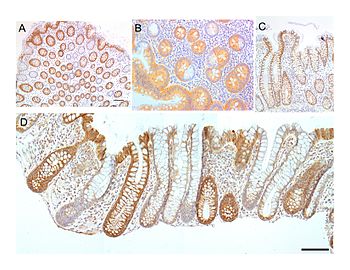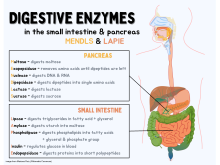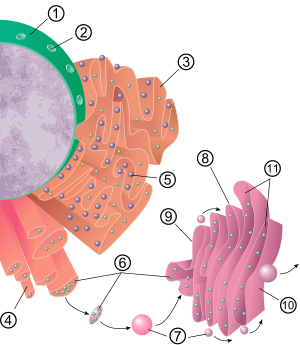From Wikipedia, the free encyclopedia
https://en.wikipedia.org/wiki/First_universal_common_ancestor
The first universal common ancestor (FUCA) is a proposed non-cellular entity that was the earliest organism with a genetic code capable of biological translation of RNA molecules into peptides to produce proteins. Its descendents include the last universal common ancestor (LUCA) and every modern cell. FUCA would also be the ancestor of ancient sister lineages of LUCA, none of which have modern descendants, but which are thought to have horizontally transferred some of their genes into the genome of early descendants of LUCA.
FUCA is thought to have been composed of progenotes, proposed ancient biological systems that would have used RNA for their genome and self-replication. By comparison, LUCA would have had a complex metabolism and a DNA genome with hundreds of genes and gene families.
Origins
Long before the appearance of compartmentalized biological entities like FUCA, life had already began to organize itself and emerge in a pre-cellular era known as the RNA world. The universal presence of both biological translation mechanism and genetic code in every biological systems indicates monophyly, a unique origin for all biological systems including viruses and cells.
FUCA would have been the first organism capable of biological translation, using RNA molecules to convert information into peptides and produce proteins. This first translation system would have been assembled together with primeval, possibly error-prone genetic code. That is, FUCA would be the first biological system to have genetic code for proteins.
The development of FUCA likely took a long time. FUCA was generated without genetic code, from the ribosome, itself a system evolved from the maturation of a ribonucleoprotein machinery. FUCA appeared when a proto-peptidyl transferase center started to first emerge, when RNA world replicators started to be capable to catalyze the bonding of amino acids into oligopeptides.
The first genes of FUCA were most likely encoding ribosomal, primitive tRNA-aminoacyl transferases and other proteins that helped to stabilize and maintain biological translation. These random peptides produced possibly bound back to the single strand nucleic acid polymers and allowed a higher stabilization of the system that got more robust and was further bound to other stabilizing molecules. When FUCA had matured, its genetic code was completely established.
FUCA was composed by a population of open-systems, self-replicating ribonucleoproteins. With the arrival of these systems, began the progenote era. These systems evolved into maturity when self-organization processes resulted in the creation of a genetic code. This genetic code was for the first time capable to organize an ordered interaction between nucleic acids and proteins through the formation of a biological language. This caused pre-cellular open systems to then start to accumulate information and self-organize, producing the first genomes by the assembly of biochemical pathways, which probably appeared in different progenote populations evolving independently.
In the reduction hypothesis, where giant viruses evolved from primordial cells that became parasitic, viruses might have evolved after FUCA and before LUCA.
Progenotes
Progenotes (also called ribocytes or ribocells) are semi-open or open biological systems capable of performing an intense exchange of genetic information, before the existence of cells and LUCA. The term progenote was coined by Carl Woese in 1977, around the time he introduced the concept of the three domains of life (bacteria, archaea, and eukaryotes) and proposed that each domain originated from a different progenote. The meaning of the term changed with time. In the 1980s, Doolittle and Darnell used the word progenote to designate the ancestor of all three domains of life, now referred to as the last universal common ancestor (LUCA).
The terms ribocyte and ribocell refer to progenotes as protoribosomes, primeval ribosomes that were hypothetical cellular organisms with self-replicating RNA but without DNA, and thus with a RNA genome instead of the usual DNA genome. In Carl Woese's Darwinian threshold period of cellular evolution, the progenotes are also thought to have had RNA as informational molecule instead of DNA.
The evolution of the ribosome from ancient ribocytes, self-replicating machines, into its current form as a translational machine may have been the selective pressure to incorporate proteins into the ribosome's self-replicating mechanisms, so as to increase its capacity for self-replication. Ribosomal RNA is thought to have emerged before cells or viruses, at the time of progenotes.
Progenotes composed and were the descendants of FUCA, and FUCA is thought to have organized the process between the initial organization of biological systems and the maturation of progenotes. Progenotes were dominants in the Progenote age, the time where biological systems originated and initially assembled. The Progenote age would have happened after the pre-biotic age of the RNA-world and Peptide-world but before the age of organisms and mature biological systems like viruses, bacteria and archaea.
The most successful progenotes populations were probably the ones capable to bind and process carbohydrates, amino acids and other intermediated metabolites and co-factors. In progenotes, compartmentalization with membranes was not yet completed and translation of proteins was not precise. Not every progenote had its own metabolism; different metabolic steps were present in different progenotes. Therefore, it is assumed that there existed a community of sub-systems that started to cooperate collectively and culminated in the LUCA.
Ribocytes and viruses
In the eocyte hypothesis, the organism at the root of all eocytes may have been a ribocyte of the RNA-world. For cellular DNA and DNA handling, an "out of virus" scenario has been proposed: storing genetic information in DNA may have been an innovation performed by viruses and later handed over to ribocytes twice, once transforming them into bacteria and once transforming them into archaea.
Similarly in viral eukaryogenesis, a hypothesis theorizing that eukaryotes evolved from a DNA Virus, ribocytes may have been an ancient host for the DNA virus. As ribocytes used RNA to store their genetic info, viruses may initially have adopted DNA as a way to resist RNA-degrading enzymes in the host ribocells. Hence, the contribution from such a new component may have been as significant as the contribution from chloroplasts or mitochondria. Following this hypothesis, archaea, bacteria, and eukaryotes each obtained their DNA informational system from a different virus.
















